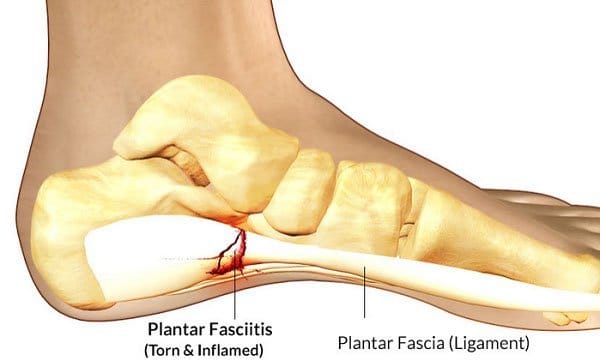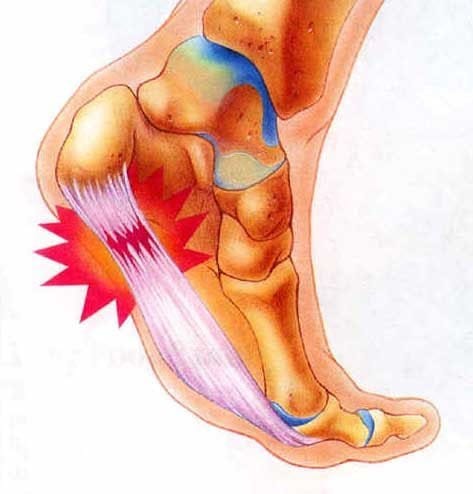Experiencing pain and stiff muscles in the morning is very common. However, these symptoms can be downright debilitating when they impact the foot. This is generally what sufferers of plantar fasciitis experience when they first wake up in the morning. When they place their foot on the ground, an intense pain will shoot through their entire body. In some severe cases, this will bring a tear to their eye. Plantar fasciitis is undeniably a devastating condition, but it is not a hopeless battle. Within this comprehensive guide, you’ll learn about some of the top natural remedies for plantar fasciitis.
Inserting Toe Separators
When you see someone utilizing toe separators, you’ll probably think that they’re insane. This is a major misconception. While the appearance might look a little odd, toe separators can prove to be enormously beneficial for alleviating the pain associated with plantar fasciitis. You can use the foam toe separators that are commonly used for pedicure purposes. Insert them between your toes and this will begin stretching the muscles in the foot.
By performing this activity for a brief period, you’ll be able to reduce the pain, while also eliminating the stiffness. This will allow you to live a pain-free life, while also enhancing your mobility. Toe separators can be purchased from most retail stores and online. Therefore, you should not have any trouble getting your hands on these products!

Losing Weight
There are various health complications that can increase your chances of suffering from plantar fasciitis. One of the most notable is definitely obesity. Being overweight means that your feet are going to be responsible for lugging around a much greater amount of weight. In return, this can lead directly to plantar fasciitis. The good news is that it is entirely possible to reverse this problem. By losing weight and slimming down your waistline, you’ll be able to take the extra pressure off of your legs, knees, and feet.
Simultaneously, this will diminish your pain and increase your mobility.
Magnetic Therapy
There are many possible natural remedies for plantar fasciitis, but magnetic therapy is gaining in popularity very rapidly. Wearing magnetic insoles may be able to provide you with the relief that you desire. Just remember that studies of “magnets for pain” , have been unable to link magnets to pain relief. Nevertheless, a lot of practitioners of magnetic therapy strongly believe that magnets provide them with the relief that they desperately need. Therefore, it is definitely worth giving a try.
Wearing magnetic insoles will have no negative side effects or risks. And, these insoles are readily available and affordable. With this in mind, they’re definitely well worth experimenting with on your own.
Proper Shoes
Not everyone with plantar fasciitis has the option of wearing shoes that are designed specifically to improve the condition. In fact, many women who wear stilettos and men who wear work boots suffer from the condition. However, they are forced to wear these particular shoes for their job. When you are on your own, you should only wear shoes that are designed to relieve the symptoms associated with plantar fasciitis.
Good shoes for plantar fasciitis should offer superior arch support, thick cushioning, shock absorbency protection, comfort, stability and flexion at the toebox. If any component of the shoes is lacking in quality, it could lead to tears in the plantar fascia muscle band. Wear the right shoes, so you can avoid the debilitating pain associated with this unique condition.
Utilizing Ginger
Believe it or not, ginger offers a wealth of benefits to the user. It is overflowing with beneficial bioactive compounds and nutrients that will deliver benefits to the brain and body. Plus, it is commonly believed that ginger will deliver benefits for patients of plantar fasciitis. Ginger is believed to be able to diminish muscle pain and soreness. Research has confirmed that ginger can be very beneficial, thanks to its anti-inflammatory properties. Therefore, if you’re sick of waking up in the morning with intense pain and a stiff foot, you should definitely consider using ginger.
This may not completely rectify the problem at its source, but it will provide you with a little bit of relief when you need it the most!

Apple Cider Vinegar
Apple cider vinegar has been utilized for just about everything, including a food flavoring, treatment for an array of illnesses and canning purposes. The anti-inflammatory properties found in apple cider vinegar are capable of reducing inflammation, which in turn will reduce pain.
You can make an apple cider vinegar soak, by adding a quarter of a cup to each gallon of warm water. It is recommended to soak your feet in the solution for 15 to 20 minutes or until the water begins to get cold. Some of the people from the older generation recommend soaking a piece of brown paper bag in the solution and then applying it to the plantar fascia.
Apple cider vinegar is also considered to be an astringent, which is basically an antiseptic. You can apply it to sores or broken skin to speed up the healing process.
Wearing A Night Splint
Remember that plantar fasciitis tends to worsen during the night and its symptoms are most intense in the morning. Therefore, it might be best to take action to combat the problem at night. There is where a good night splint will enter the picture. This is nothing more than a unique brace that is designed to keep the foot stretched throughout the night. The brace will support the foot during the night, so that the patient will feel far less pain and stiffness in the morning.
Night splints can be used in conjunction with stretching exercises for the maximum impact. While there are many generic night splits, it is generally best to choose one that is specifically designed for your foot. This will ensure that you get the results you desire with minimal risks.
Foot Massages
The symptoms associated with plantar fasciitis are often linked to the inflammation or swelling. With this in mind, a good massage might be a wise option. Massages are known to promote improved blood flow. In fact, research has confirmed that massage therapy can improve circulation, while also alleviating muscle soreness. By massaging the foot and the tendon, it will be possible to decrease the pain experienced, while also reducing the inflammation. In return, you’ll feel much better and your foot will gain more mobility.
You can also combine massage with ice therapy to obtain more dramatic results. Try icing the area for a good fifteen minutes, before giving the impacted area a good rub down. This will deliver noticeable results.

Stretching Exercises
Plantar fasciitis is not considered a debilitating condition, but if it is not treated properly, the symptoms can prevent you from living life to the fullest. The key to improving your condition is routine stretching exercises. While some people with plantar fasciitis will rely on yoga poses, others will prefer stretching exercises that target the muscles in the hips, thighs and calf, as well as the deep tissue in the feet.
You do not need to work out for hours, just to receive the maximum benefits of these exercises. Instead, you need to commit to a regimen and stick with it. It may take a bit of practice to get the exercise down pat, but this should not be an issue, since you are working to improve your condition.
It is highly recommended to perform the stretching exercises as soon as you wake up in the morning. This is the time, when the muscles in your lower body will be the stiffest. The stretches are specifically designed to target muscles and tissues that cause inflexibility. When you stretch the target area, you are increasing the flexibility and relieving the pain associated with plantar fasciitis.
Rest Frequently
People who stand on their feet are always going to be at a higher risk of developing plantar fasciitis. Standing in one position for long periods of time, lifting heavy objects or walking for prolonged periods can lead to plantar fasciitis. Once the condition has developed, the only option you will have is to treat it properly. Along with treatment, you should take frequent rest breaks. While this is not always possible, while working a job that requires constant standing or walking, you should be able to catch a few minutes of rest.
Put your feet up during breaks and if necessary remove your shoes and massage your feet. Do your best to pamper your feet, because they take a beating each and every day. When you are at home, prop your feet up as much as you possibly can.
Cold Therapy
Cold therapy is utilized to treat an array of conditions and injuries. The cold temperatures are capable of decreasing inflammation, which in turn will reduce your pain level. However, it is important to note that cold therapy is not suitable for everyone. In fact, it is not unusual for some people to experience more pain, when the ice is applied directly to the plantar fascia. It is possible to reduce the cold temperatures by wrapping a towel around the water bottle or bag of ice, before application.
If you continue to experience pain during the treatment, you should discontinue it immediately. For those that find the treatment beneficial, you should experience instant relief.
Turmeric
Turmeric is a very popular spice among Chinese chefs and others. The spice has been utilized for decades as a food flavoring, to give cosmetics color and treat specific illnesses. Herbalists and naturalists believe turmeric is capable of treating heartburn, joint pain, Chron’s disease, diarrhea, decreased appetite and plantar fasciitis.
The chemical found in turmeric that makes it is so effective is known as curcumin. This chemical may reduce edema and inflammation, which is often linked to plantar fasciitis. By reducing the inflammation, it is possible to decrease your pain level and improve your flexibility. However, to receive the maximum benefits of turmeric, you should add the spice to a cup of warm milk.
It is recommended to add one teaspoon of turmeric to eight ounces of warm milk. This concoction should be consumed twice a day once when you get out of bed and again before you go to bed. Now, you may not receive instant relief, but do not discontinue the regimen. Everyone’s body is different, so the effects will vary from one person to another. It may take several doses, before you begin to feel any relief or improvements in your condition.

